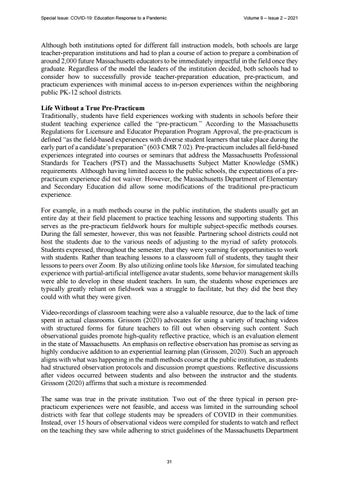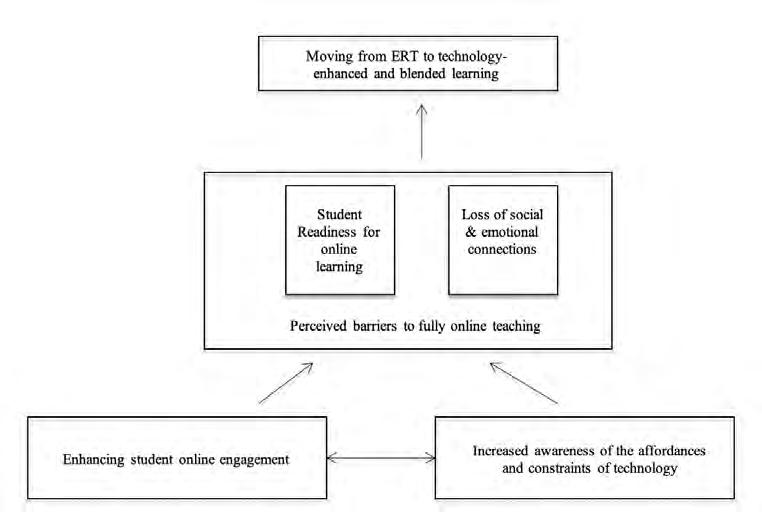Special Issue: COVID-19: Education Response to a Pandemic
Volume 9 – Issue 2 – 2021
Although both institutions opted for different fall instruction models, both schools are large teacher-preparation institutions and had to plan a course of action to prepare a combination of around 2,000 future Massachusetts educators to be immediately impactful in the field once they graduate. Regardless of the model the leaders of the institution decided, both schools had to consider how to successfully provide teacher-preparation education, pre-practicum, and practicum experiences with minimal access to in-person experiences within the neighboring public PK-12 school districts. Life Without a True Pre-Practicum Traditionally, students have field experiences working with students in schools before their student teaching experience called the “pre-practicum.” According to the Massachusetts Regulations for Licensure and Educator Preparation Program Approval, the pre-practicum is defined “as the field-based experiences with diverse student learners that take place during the early part of a candidate’s preparation” (603 CMR 7.02). Pre-practicum includes all field-based experiences integrated into courses or seminars that address the Massachusetts Professional Standards for Teachers (PST) and the Massachusetts Subject Matter Knowledge (SMK) requirements. Although having limited access to the public schools, the expectations of a prepracticum experience did not waiver. However, the Massachusetts Department of Elementary and Secondary Education did allow some modifications of the traditional pre-practicum experience. For example, in a math methods course in the public institution, the students usually get an entire day at their field placement to practice teaching lessons and supporting students. This serves as the pre-practicum fieldwork hours for multiple subject-specific methods courses. During the fall semester, however, this was not feasible. Partnering school districts could not host the students due to the various needs of adjusting to the myriad of safety protocols. Students expressed, throughout the semester, that they were yearning for opportunities to work with students. Rather than teaching lessons to a classroom full of students, they taught their lessons to peers over Zoom. By also utilizing online tools like Mursion, for simulated teaching experience with partial-artificial intelligence avatar students, some behavior management skills were able to develop in these student teachers. In sum, the students whose experiences are typically greatly reliant on fieldwork was a struggle to facilitate, but they did the best they could with what they were given. Video-recordings of classroom teaching were also a valuable resource, due to the lack of time spent in actual classrooms. Grissom (2020) advocates for using a variety of teaching videos with structured forms for future teachers to fill out when observing such content. Such observational guides promote high-quality reflective practice, which is an evaluation element in the state of Massachusetts. An emphasis on reflective observation has promise as serving as highly conducive addition to an experiential learning plan (Grissom, 2020). Such an approach aligns with what was happening in the math methods course at the public institution, as students had structured observation protocols and discussion prompt questions. Reflective discussions after videos occurred between students and also between the instructor and the students. Grissom (2020) affirms that such a mixture is recommended. The same was true in the private institution. Two out of the three typical in person prepracticum experiences were not feasible, and access was limited in the surrounding school districts with fear that college students may be spreaders of COVID in their communities. Instead, over 15 hours of observational videos were compiled for students to watch and reflect on the teaching they saw while adhering to strict guidelines of the Massachusetts Department
31



